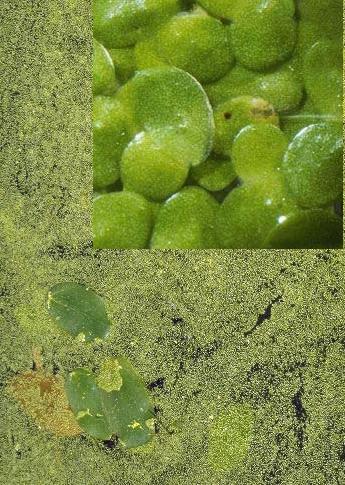July
2002
Did you know that
the pond plant Wolffia arrhiza is the smallest flowering plant in the
world, so small that you could fit 25 of them across your fingernail?
 |
|
Wolffia arrhiza
|
- Wolffia arrhiza
Wolffia arrhiza belongs in Lemnaceae family These plants are the smallest plants in the
world.
They look like green grains floating in the water. The most common is
W. arrhiza, Water Meal or Rootless Duckweed. It is native to Africa,
Brazil, Western Asia and Europe. This plant isn't grown in the water
garden purposely, but can sometimes be found in portions of other
aquatic plants. This plant can become very troublesome in natural
ponds; turning the water bright green.
Wolffia arrhiza, a small floating
plant, in flowers, without root. The
shape of plant body is ovoid to nearly spherical with a distinctly
flattened, dark green dorsal surface, floating with only central
portion of dorsal surface above water; without brown pigment cells.
Its size is 0.8-1.3 mm long without veins. This
plant is so small you could fit 25 of them across your fingernail. The
flower is one funnel-shaped pouch at basal end, within floral
cavity on dorsal surface, not enclosed by a spathe.
The plant is Floating at surface of quiet streams and
ponds, often mixed with other Lemnaceae and aquatic plants.
Wolffia
arrhiza has traditionally been eaten in Myanmar, Laos, and northern
Thailand (Bhanthumnavin and McCarry 1971). The duckweed cultivated in
these areas is sold on local markets, however, since it is regarded as
the "poor man's food", interest is apparently declining.The
use of Lemnaceae for human consumption has surprisingly not spread to
other regions of the world. A possible explanation could be its high
content of crystallised oxalic acid which has a negative effect on the
taste. Another factor contributing to the low interest in duckweed as
a potential food product for human consumption could be attributed to
the fact that it is difficult to separate associated (pathogenic)
organisms such as worms, snails, protozoa, and bacteria from the plant.
Source:
http://www.botany.com/wolffia.html
http://www.i55mall.com/aquaponics/2001/08/20010827.html
http://waynesword.palomar.edu/woar.htm
|
